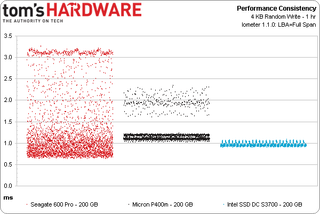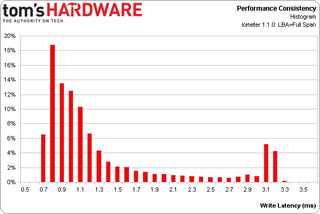Seagate 600 Pro-Series 200 GB SSD Review: For The Enterprise
After years of halfhearted attempts to join the solid-state storage market, Seagate is finally ready to reinvent itself with a new family of SSDs. The first one we're looking at is the enterprise-class 600 Pro. Does this 200 GB drive impress our team?
Results: Performance Consistency
Increasingly, we pay close attention to the performance consistency of enterprise-class SSDs. This is what separates a good drive from a great one when all of the corner case testing seems equal. Over the past year, we measured this in terms of large block transfers in our Enterprise Video Streaming section. Armed with this data and our exclusive analysis, the peaks, valleys, and frequency of each become clear. If you look at the information for long enough, you start to see fingerprints for each drive.
We started with large block transfers because, in enterprise video applications, if you don't buffer or write data fast enough, you can lose it completely. Random 4 KB transfers are slightly more academic, but they also match database transfers more closely. With this sort of workload, you might not lose data, but the system will slow down.
For the following tests, we subjected Seagate's 600 Pro, along with Micron's P400m and Intel's SSD DC S3700, to 25 hours of continuous random 4 KB writes across each entire drive. We recorded the IOPS every second, giving us 90,000 data points. We then zoomed in to the last 60 minutes to more coherently visualize the results.

As you can see, the P400m and SSD DC S3700 are stellar performers, which we already knew going in. The 600 Pro's results surprised us a little, though. We didn't necessarily expect Seagate's new SSD to match the higher-priced competition. However, the amount of variance it demonstrates is quite high.

More positively, the 600 Pro posted at least 40,000 IOPS (0.8 ms or less response time) on 25% of its transfers. But, as the histogram also shows us, almost 10% of the drive's transfers took more than 3 ms (less than 11,000 IOPS). Some of the other SSD vendors limit raw I/O performance to maintain more consistency; this does not appear to the case here, though. If you watch Iometer as the test runs, its variability is apparent. The value of the last update jumps between 8,000 and 40,000+ IOPS.
We did notice that if you limit your write area to 100 GB, manually over-provisioning, in essence, the variability disappears. This makes sense because, as the number of spare cells increases, the controller manages their use more effectively. This also tells us that the amount of spare capacity and the memory's performance is responsible for the ups and downs, rather than an issue with the controller architecture. Interestingly, Seagate rates its 240 GB 600 Pro 11,000 4 KB random write IOPS, which is almost exactly where that top distribution centers around. Unfortunately, since we only have the 200 GB version to test, we couldn't double-check those numbers.
Now, to put all of this information into perspective. If you're looking at worst-case scenarios, Intel's SSD DC S3700 is the way to go; even Micron's P400m gives you great consistency. At its worst, the 200 GB 600 Pro is a 10,000-IOPS drive. But at best, expect to see more than 40,000 IOPS. If your application writes in bursts, giving the 600 Pro time to recover, it is an excellent option.
Stay On the Cutting Edge: Get the Tom's Hardware Newsletter
Join the experts who read Tom's Hardware for the inside track on enthusiast PC tech news — and have for over 25 years. We'll send breaking news and in-depth reviews of CPUs, GPUs, AI, maker hardware and more straight to your inbox.
Current page: Results: Performance Consistency
Prev Page Results: 4 KB Random Performance And Latency Next Page Results: Enterprise Workload Performance-
mayankleoboy1 1. Would it have made sense to add more DRAM to increase performance ? On a SSD this expensive, 1GB RAM would hardly add 20$ or so.Reply
2. On the first page, the fourth paragraph :"Today, Seagate ........... bench today."
You completely went over my head. It appears you are just throwing names around. Maybe reword that para again ? or explain here ? :) -
Lrxst WD bought SiliconSystems in 2009 and has been making WD branded SiliconDrives. I put one in my i5 build shortly after they came out, and I feel like I am the only one who bought one for home use. They still make them, but are focusing on embedded systems at this point. Maybe Seagate will have more luck, but there are a lot of well established players already. I'm pretty luke-warm on Seagate. How do you know your Seagate SSD is on the verge of failure without the telltale Seagate Click of Death®?Reply -
drewriley mayankleoboy11. Would it have made sense to add more DRAM to increase performance ? On a SSD this expensive, 1GB RAM would hardly add 20$ or so.2. On the first page, the fourth paragraph :"Today, Seagate ........... bench today." You completely went over my head. It appears you are just throwing names around. Maybe reword that para again ? or explain here ?Reply
1) With the DRAM-to-NAND ratio already being 1MB->1GB it is already fairly aggressive, it may have helped with performance consistency, but I don't think you would see much improvement.
2) Basically, Seagate announced 4 products today
a) Seagate 600 Pro - Entry level, read-focused, enterprise SSD
b) Seagate 600 - Consumer SSD, which we will have reviewed tomorrow
c) Seagate 1200 - High-end, dual-port, 12Gbps SAS SSD
d) X8 Accelerator - High-end plug-in PCIe SSD
Hope this helps.
Drew -
drewriley LrxstWD bought SiliconSystems in 2009 and has been making WD branded SiliconDrives. I put one in my i5 build shortly after they came out, and I feel like I am the only one who bought one for home use. They still make them, but are focusing on embedded systems at this point. Maybe Seagate will have more luck, but there are a lot of well established players already. I'm pretty luke-warm on Seagate. How do you know your Seagate SSD is on the verge of failure without the telltale Seagate Click of Death®?Reply
You're the one that bought that drive :-) You are right on point with WD/Silicon Systems. They were primarily an embedded flash vendor prior to acquisition. If you look at their webpage, you will see that they only offer SLC-based drives.
-
mayankleoboy1 drewriley1) With the DRAM-to-NAND ratio already being 1MB->1GB it is already fairly aggressive, it may have helped with performance consistency, but I don't think you would see much improvement.2) Basically, Seagate announced 4 products today a) Seagate 600 Pro - Entry level, read-focused, enterprise SSD b) Seagate 600 - Consumer SSD, which we will have reviewed tomorrow c) Seagate 1200 - High-end, dual-port, 12Gbps SAS SSD d) X8 Accelerator - High-end plug-in PCIe SSDHope this helps.DrewReply
Thanks, Drew. This made the paragraph clearer. -
thecynicalmonk "For The Enterprise" Bout time the USS Enterprise got an upgrade! No more waiting for the holo-deck to buffer!! lolzReply -
danwat1234 "For The Enterprise", lol they use isolinear rods and chips. I doubt these SSDs can compete against those at any angle. Maybe from a reliability perspective.Reply -
rgeiken I have had several Seagate drives in the past and they both had reliability issues after their first year. Right now, Seagate is on my Do Not Buy List!!!! For any magnetic hard drive, I would select WD. Have had pretty good luck with that company. When any company produces parts that fail prematurely and then don't supply a replacement promptly, then they are on my DNB List. I will probably buy a Samsung SSD shortly, since with Samsung I have always had good performance and reliability.Reply -
bards1888 The DRAM on the SSD is typically only used to store the indirection table, it does not cache user data.Reply
Most Popular



